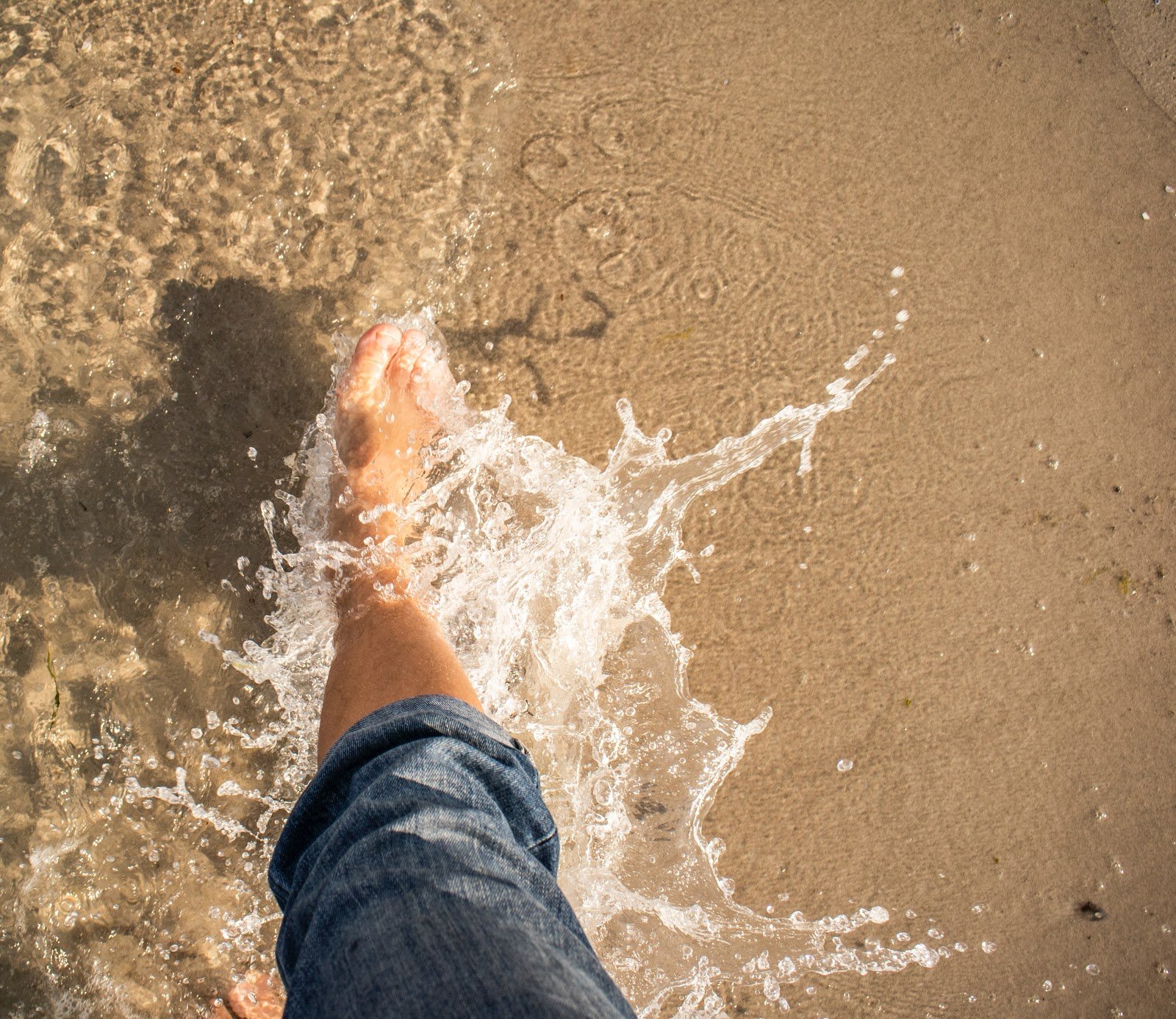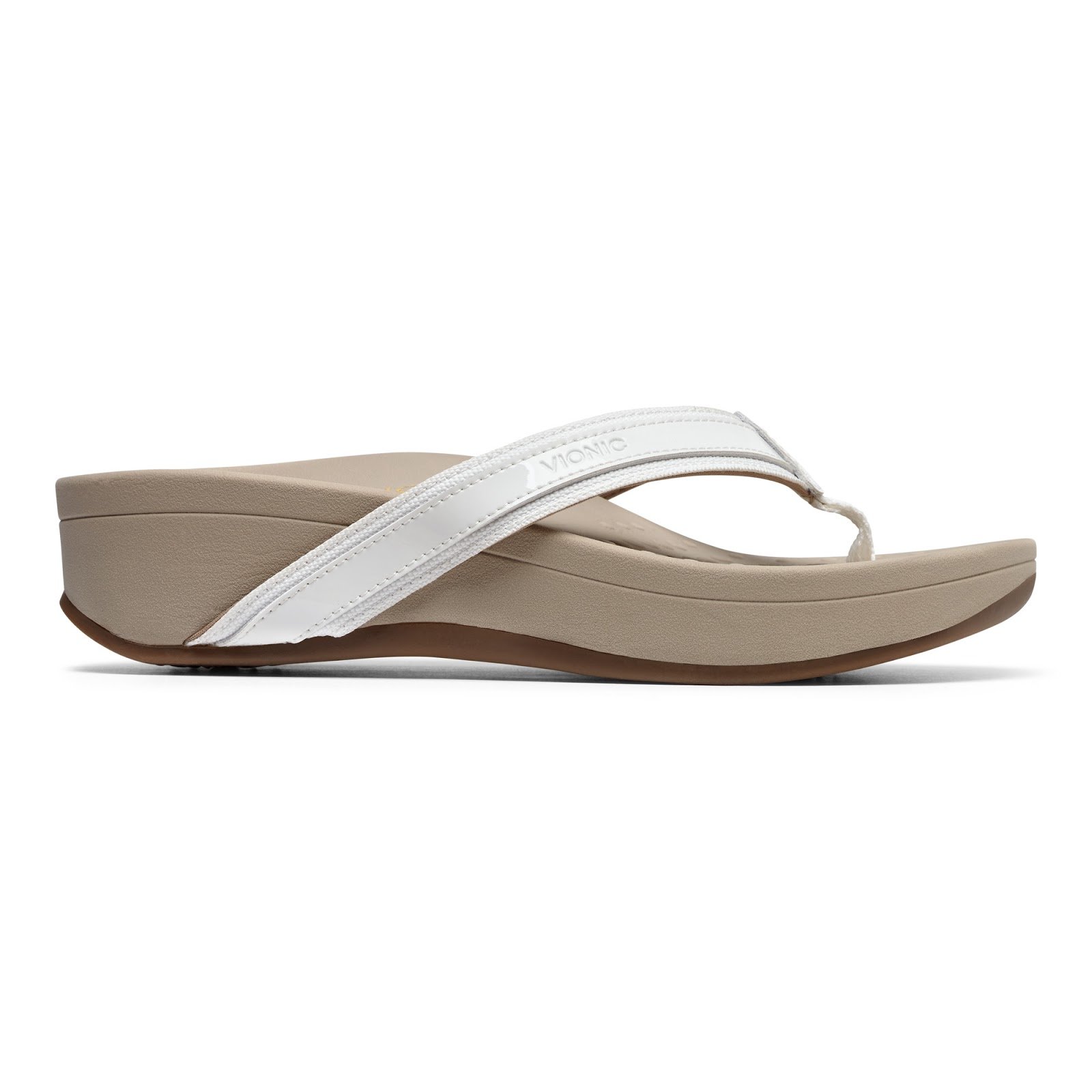
Here at Vionic, we’re big fans of the sand and sea. Thanks to our surf-loving founder, podiatrist Phillip Vasyli, we offer some of the best beach sandals on the market, including an exceptional range of beach shoes for women. He sought to create comfy, supportive footwear for everyone and every occasion, including strolling along the shore and splashing in the tide.
There’s a lot to love about the ocean. If you ask us, lounging in the sun, walking in the sand, and dipping your toes into the crisp saltwater sounds like the perfect way to spend a day off. Having said that, the seaside elements that make you feel so good can also harm your feet. Here’s how you can protect your feet at the beach.

Protect Your Feet from Hot Sand and Sidewalks
Walking in the sand is excellent exercise. The sinking particles and uneven terrain create added resistance, making your muscles and lungs work a little harder.¹ Hello, muscle-toning and cardio!
When you see the glistening shoreline ahead, it’s tempting to prance around barefoot without a care in the world. Don’t get us wrong—we love a good beach walk, but on really hot days, the scalding beach sand can burn the soles of your feet. Those who hardly ever go barefoot or haven’t been out on the beach for a while are particularly susceptible, as they don’t have protective calluses on their feet.
Aside from hot sand, walking barefoot on the sidewalk, parking lot, or other paved surfaces can lead to burns. You could end up with redness, blisters, or severe pain for a few days.¹ If the sand has you hopping around or running to stick your feet in the water, it’s too hot. Your best bet is to wear shoes while at the beach—or at least until you can confirm the sand is a safe temp for walking.
Slather on the Sunscreen
This should go without saying, but wearing sunscreen at the beach is non-negotiable. And when we say wear sunscreen, we mean from head to toe. While hot sand can burn the bottoms of your feet, the sun’s UV rays can burn them from the top.
It’s easy to skip over your feet when applying SPF. Maybe you’re wearing shoes, maybe you figure your feet will be in the water most of the time, or perhaps you just forget. In any case, feet can get just as sunburned as the rest of your body—sometimes even worse, since they get the least sun exposure on most other days.
The basic rule of thumb for applying sunscreen is that you need about a teaspoon for every body part.³ This means a teaspoon for your face, one for each arm, one for your belly, one for each part of your legs, and one teaspoon for your feet. It might seem like a lot at first, but the truth is, most people don’t apply enough SPF for it to be effective. Slather it onto your feet, making sure to cover your ankles, in between your toes, and even the bottoms of your feet in case you flip over onto your front for a seaside snooze.
Even if you plan to be wearing shoes or swimming most of the time, you should still apply sunscreen every couple of hours. The water can wash it off, and just 15 minutes of direct sunlight is enough to get a sunburn.
Are Your Feet Peeling After the Beach? Try This
Sunburns happen, even when you’re diligent about applying SPF. You should do your best to avoid too much sun exposure, but in the event you do get burned, you should know how to treat it from home.
The oceanside is full of all kinds of intense elements—heat, wind, salt, dry air, humidity, and scratchy particles—all of which can lead to peeling skin.⁴ If you notice your feet are peeling after spending time at the beach, there are a few things you can try.
At-home remedies for peeling feet:
- Soak your feet in a warm footbath for 20 to 30 minutes to soften the skin, then massage with a gentle exfoliating scrub.
- Soak your feet in a warm bath with a half-cup of epsom salt and a drizzle of olive oil.
- Soak your feet in a footbath with two parts water and one part apple cider vinegar.
- Apply a thick moisturizer to your feet two or more times a day, and put socks on immediately after.
When your feet are cracked and peeling, it’s also important to keep them clean and dry. This helps prevent athlete’s foot and other fungal infections.
How to Prevent Swollen Feet at the Beach
Spending time at the beach can lead to heat edema (swollen ankles and feet). When hot weather makes your body temperature rise, your blood vessels expand.⁵ As a result, fluids are pulled down toward your feet by gravity.
People with diabetes and other conditions that affect circulation may have a higher risk of swelling. Also, those who live in colder climates and aren’t used to high temperatures might experience heat edema.
In some cases, swollen feet at the beach may be unavoidable. However, there are a handful of things you can do to keep it to a minimum. We recommend bringing plenty of water and staying hydrated throughout the day. Also, avoid eating foods high in sodium. And stay in the shade as much as possible to prevent overheating.
Preventing Cuts and Scrapes on the Beach
The sand and sea are full of scratchy debris, sharp rocks, broken sharp shells, and sadly, sometimes shattered glass and shards of plastic. You definitely want to avoid cuts and scrapes on the sandy beach, as an open wound can lead to infections, especially when it’s exposed to sand.
When walking on the beach, we suggest wearing supportive walking sandals, espadrilles, or lightweight sneakers. And when you’re splashing in the waves or swimming in the reef, waterproof shoes are highly recommended. If you can’t see your feet, it’s almost impossible to avoid scrapes in the water.
Keep the Sand Out of Your Shoes
If you wear closed-toe shoes at the beach, try to keep sand out of them. While you might not be able to avoid every last particle, the scratchy bits can rub against your skin when you walk around. This can lead to scratches, sores, and blisters.

Try Supportive Footwear
Walking and running around on the uneven sand can cause plantar fasciitis (heel pain), overpronation, tender arches, Achilles tendonitis, Morton’s neuroma, a sprained ankle, or another foot-related injury. We’re all about letting loose at the beach, but you can be more carefree when you know your feet are protected with supportive footwear.
Many of the shoes we carry at Vionic are designed specifically for staying active at the beach. From toe-post sandals and slides to durable contoured flip-flops and flexible slip-on sneakers, we have something for everyone and every taste. Not only that, but each pair is embedded with our exclusive Vio Motion Support orthotics—all hidden within the sole.
No one loves an easy-breezy beach day more than the team at Vionic. And when you try out our shoes, we think you’ll find a new appreciation for everything the ocean has to offer. Shop our beach-ready styles today.
External sources:
1. Michele Stanten. “11 Tips to Get the Most Out of Beach Walking”. Verywell Fit. Updated on December 22, 2020, https://www.verywellfit.com/tips-for-walking-on-the-beach-4065400
2. “Don’t Let Your Feet Ruin Your Day at the Beach”. Foot Health Facts. https://www.foothealthfacts.org/article/don-t-let-your-feet-ruin-your-day-at-the-beach
3. “How much sunscreen do I need?”. Consumer Reports. May 14, 2015, https://www.consumerreports.org/cro/magazine/2015/05/how-much-sunscreen-to-apply/index.htm
4. “7 Ways to Remove Dead Skin from Your Feet”. Healthline. https://www.healthline.com/health/how-to-remove-dead-skin-from-feet
5. “Heat edema (swelling)”. Unversity of Michigan Health. https://www.uofmhealth.org/health-library/not245134#not245134-sec



Debbie
Thanks for sharing vital information about danger of serious burns on feet. A dear friend with diabetes got serious burns walking on beach without shoes. The burns never healed and subsequently led to amputation of his foot.